|
||||||||||
|
|
||||||||||
|
||||||||||
|
|
||||||||||
Mercury is the only planet with no real atmosphere to speak of. The world is too small with gravity too weak to hold on to large quantities of atmospheric gas. However, Mercury does maintain a very thin and transitory atmosphere consisting of a varied assortment of gases. Major constituents include potassium, sodium, oxygen, helium, hydrogen, and water vapor. Researchers are not entirely sure what produces this atmosphere, but the leading theory is that it comes from the solar wind, outgassing due to radioactive decay from the surface, and comet impacts. The solar wind brings hydrogen and helium blasted from the Sun into Mercury's weak magnetic field where the atoms are slowed down enough to be temporarily captured by the planet's gravitational field. Sodium and potassium are probably the result of radioactive decay while other elements and water vapor may be deposited by comets striking the planet.
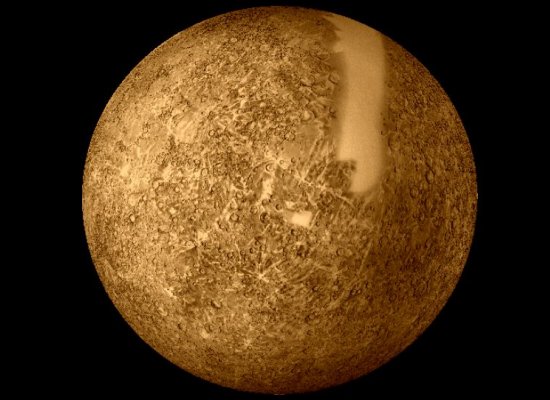
However, Mercury is very hot given its close proximity to the Sun. This heat increases the energy of the atoms and molecules in the tenuous atmosphere so they quickly escape Mercury's weak gravitational attraction and head off into space. The solar wind continuously replenishes the atmosphere, but these gases cannot accumulate and the atmosphere remains virtually nonexistent compared to larger planets. As a result, Mercury does not experience weather and has no winds to speak of. The temperature on its surface is dictated purely by exposure to sunlight, ranging from a peak of 430°C (805°F) along the equator facing the Sun to as low as -180°C (-290°F) in permanently shadowed craters at the poles.
Venus, meanwhile, has the densest and perhaps the most hostile atmosphere of any planet in the solar system. Scientists speculate that Venus and Earth had very similar atmospheres early in their histories, but the two worlds have taken drastically different paths since. Being closer to the Sun, Venus receives considerably more heating than Earth. This solar energy likely evaporated liquid water on its surface, and water vapor traps heat causing temperatures to rise. The increasing temperature released carbon dioxide from surface rocks thickening the atmosphere and raising temperatures even higher. This repeating cycle eventually reached a critical level turning the Venutian atmosphere into a furnace.

The atmosphere is almost entirely carbon dioxide with small amounts of nitrogen and numerous other gases. The dense atmosphere gives the planet a surface temperature hot enough to melt lead and a pressure more than 90 times greater than Earth's. Venus is also surrounded by thick permament clouds of sulfur dioxide and sulfuric acid that form high in the atmosphere and block most sunlight from reaching the surface. The light that does filter through is converted to heat that is unable to radiate back through the cloud layer, thereby maintaining the stifling conditions. This effect continues day and night such that temperature around the globe remains nearly constant at a blistering 460°C (865°F). The constant temperature profile in the lower atmosphere eliminates all but very light winds, but wind speeds of more than 300 km/h (185 mph) have been measured at the top of the cloud layer.
The same greenhouse effect that doomed Venus has instead made Earth warm enough for complex life to develop and thrive. Scientists believe Earth's atmosphere was originally a toxic combination of carbon, hydrogen, oxygen, and nitrogen compounds but the development of early plants changed the composition of the atmosphere into one capable of supporting animal life. Today's atmosphere predominantly consists of nitrogen and oxygen with small amounts of the greenhouse gases carbon dioxide, water vapor, and methane. These gases trap enough thermal energy from the Sun to raise the atmospheric temperature and maintain it within a habitable range over most of the planet's surface day or night.

Temperature extremes on Earth vary from a peak of 58°C (136°F) measured in Death Valley, California, in the summer to as low as -88°C (-126°F) in Antarctica. However, extremes like these are rare and the mean surface temperature across the globe is a comfortable 14°C (57°F). Without the effect produced by atmospheric gases that trap heat, however, the average surface temperature would plummet to -18°C (0°F) and would likely be too cold for complex life to have developed. Wind speeds at the surface are generally low but can reach nearly 320 km/h (200 mph) in hurricanes or cyclones, the worst storms experienced on the planet. The highest speeds on an average day can be found high in the atmosphere in a region called the jet stream where sustained winds of 55 to 120 km/h (35 to 75 mph) are typical.
While Venus and Earth owe their atmospheric properties in large part to the so-called greenhouse effect, the same cannot be said for Mars. Many scientists believe Mars once had an atmosphere dense enough and warm enough to support large bodies of liquid water on its surface. The planet has since lost its magnetic field allowing the solar wind to strip away material from the atmosphere reducing its density and pressure. The Martian atmosphere is now very thin with a surface pressure less than 1% that of Earth. The predominant substance composing the atmosphere is carbon dioxide with small amounts of nitrogen and other gases.
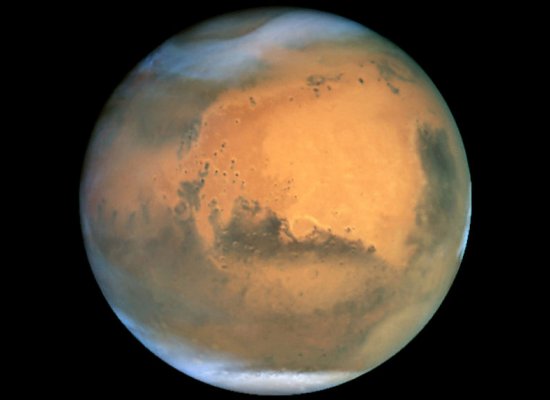
Given the planet's distance from the Sun, Mars receives less solar energy than Earth and its thin atmosphere is unable to trap much heat. Temperatures on Mars average only -46°C (-51°F). The coldest temperatures can be found at the poles during the Martian winter when the surface drops as low as -87°C (-125°F). This is so cold that as much as a quarter of the atmosphere freezes into slabs of dry ice increasing the size of the polar ice caps. Rising temperatures cause the frozen carbon dioxide to sublime back into gas generating strong winds and dust storms. Wind speeds as high as 480 km/h (300 mph) have been measured racing from the poles towards the equator stirring up great clouds of dust and creating wispy clouds of water ice.
The term atmosphere becomes more difficult to define for the outer planets, known as gas giants. Unlike the inner terrestrial planets, these worlds have no obvious surface dividing the solid planet from the gaseous atmosphere. It is believed these planets are composed of layers of increasing pressure and density. These layers range from a gaseous outer atmosphere to a liquid mantle to a solid core. For the sake of this discussion, most sources refer to "surface" conditions like pressure and temperature at the top of the cloud layer, the lowest part of the planet visible from space.

The atmospheres of all four gas giants are generally similar and are dominated by the gases hydrogen and helium. The atmospheres also contain substances like ammonia, sulfur, and methane that create the colors these planets are known for. These worlds are also quite cold given their distance from the Sun, but all are considerably warmer than the solar energy they receive can account for. The leading theory to explain the higher temperatures is that the giants generate considerable internal heat as they contract under the force of gravity. Friction created by precipitation of heavier elements through the light hydrogen atmosphere or radioactive decay of elements like uranium at the core may also be responsible for some of the interior heating.
One of the features distinguishing the atmospheres of the gas giants is the presence of lighter and darker bands of differing colors. These bands are created by various clouds composed of different substances at different altitudes and rotating around the planet at different rates. The rotation as well as upward motion of clouds into higher regions of the atmosphere is driven by convection currents due to differences in atmospheric heating. Bands are least obvious on Uranus since the planet is tilted on its side and its poles face the Sun during much of its orbit. This inclination reduces the convection effect, though recent Hubble Space Telescope imagery suggests banding is more prevalent now that the equatorial region of Uranus is facing the Sun.
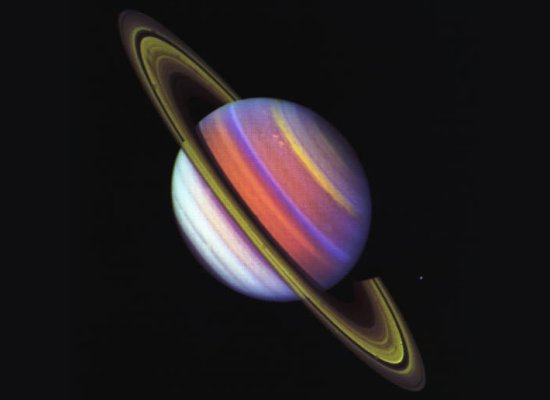
The interaction of different layers of the atmosphere driven by this convection also creates turbulence and often generates strong winds and intense storms. The largest storm ever seen is Jupiter's Great Red Spot that has existed at least as long as humans have been able to observe it. The storm is three times larger than Earth and circles Jupiter's southern hemisphere is just six days. Jupiter is also covered by many smaller storms, some of which appear and disappear within hours while others last for centuries. Similar storms have also been observed on the other gas giants, including Saturn's Great White Spot and Neptune's Great Dark Spot, though these are generally much smaller and less stable than Jupiter's mighty tempests.
Accompanying these turbulent storms are intense winds. Wind speeds of 360 km/h (225 mph) are routine in Jupiter's zonal jets while peak winds can reach 545 km/h (340 mph). Winds on Uranus are generally milder for the same reasons it has less intense bands of clouds than other gas giants, but maximum speeds of 580 km/h (360 mph) have been observed. Winds on Jupiter and Uranus pale in comparison to those of the other gas giants, however. The Voyager 2 spacecraft detected easterly winds on Saturn of 1,800 km/h (1,120 mph), but the record for windiest atmosphere in the solar system belongs to Neptune at a whopping 2,100 km/h (1,300 mph).
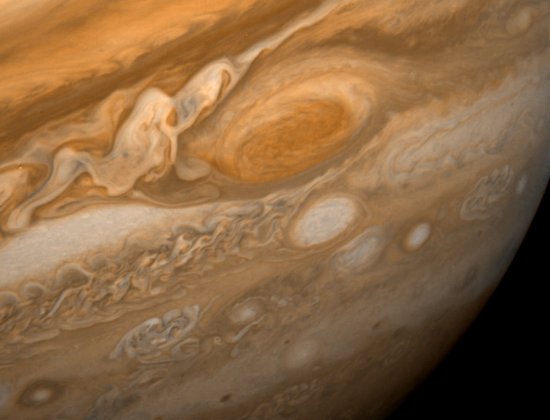
In addition to the worlds already discussed, several moons circling the planets possess atmospheres as well. Most of these are similar to the thin and virtually nonexistent atmosphere of Mercury. Earth's Moon, for example, has an extremely tenuous atmosphere consisting mostly of byproducts from radioactive decay or bombardment of meteorites and the solar wind. The exact composition is variable and may consist of gases including sodium, potassium, radon, polonium, argon, helium, oxygen, methane, carbon monoxide, or carbon dioxide.
Several of Jupiter's moons also possess a thin atmosphere. Io's tenuous atmosphere is primarily made up of sulfur dioxide from volcanic eruptions, but it is quickly stripped away by intense radiation from Jupiter and must be constantly replenished. The atmospheres of Europa and Ganymede are predominantly oxygen, but unlike Earth's oxygen that is created by plants, the gases are generated by charged particles striking the icy surfaces on the moons and splitting water into hydrogen and oxygen. The light hydrogen atoms escape the weak gravitational attraction leaving the oxygen behind. Callisto also has a thin carbon dioxide atmosphere believed to come from the slow sublimation of dry ice on its surface.
Saturn's moon Enceladus and Neptune's moon Triton also have very thin atmospheres of similar origins as Jupiter's moon Io. That of Enceladus appears to be the result of volcanoes in the southern hemisphere that spew geysers of water mixed with nitrogen, carbon dioxide, and methane. Triton likewise has geysers that erupt plumes of nitrogen and methane.

Like Mercury, the atmospheres of all of these moons are too thin to generate any winds or weather to speak of. The only moon with a fairly thick atmosphere is Saturn's largest satellite Titan. Titan's atmosphere is even denser and produces a greater surface pressure than Earth's. Composed mostly of nitrogen with small amounts of methane and numerous other gases, the atmosphere reflects most sunlight producing an "anti-greenhouse effect" that cools the surface. This phenomenon makes Titan a very cold world with an average surface temperature of just -183°C (-298°F). In 2005, NASA and the European Space Agency successfully dropped the Huygens lander through Titan's atmosphere to touch down on its frozen surface. Huygens detected very little wind on the surface, but speeds as high as 435 km/h (270 mph) were measured at high altitude. The strong winds appear to be generated by tidal forces from Saturn and produce large wind-blown sand dunes forming in parallel west-to-east lines.
Other objects in the solar system that may possess atmospheres include three bodies recently classified as dwarf planets. The closest to Earth is the asteroid Ceres, the largest asteroid in the solar system residing in the belt between Mars and Jupiter. There are indications Ceres may have a thin atmosphere, but its exact nature has yet to be determined. The best-known dwarf planet is the former planet Pluto. This distant world is believed to be covered in ices that melt as Pluto approaches the Sun in its eccentric orbit. The sublimated gases include nitrogen, methane, and carbon monoxide that form a tenuous atmosphere. As Pluto moves further from the Sun, these gases probably again freeze to the surface. Pluto's atmosphere was first detected in 1985 and continued to strengthen through 2002. NASA's New Horizons spacecraft will reach Pluto in 2015 and should be able to directly observe its atmosphere for the first time.
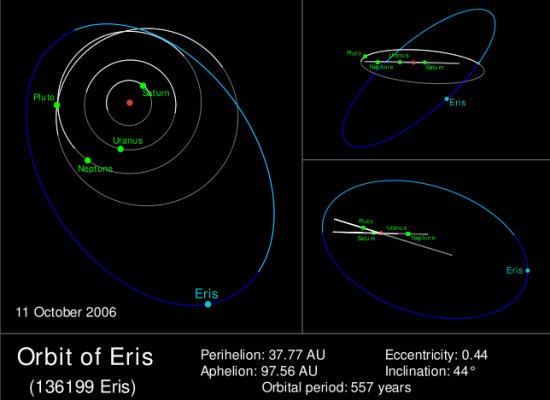
The largest of the dwarf planets is the recently discovered Eris. Eris likely shares a similar composition as Pluto with large quantities of frozen methane and other ices on its surface. The body follows a very unusual orbit that brings it almost as close to the Sun as Pluto but also far into the outer regions of the solar system. Eris is currently near its maximum distance from the Sun, but as it approaches closer in some 250 years or so, it is likely that some of the ices on its surface will thaw to create a thin atmosphere.
The atmospheric properties of the worlds described above are summarized and compared in the following table. The table includes the composition of the atmosphere and the typical pressure found at the surface as well as extremes of temperature and wind.
| Planet | Atmosphere | Surface Temperature | Max Wind Speeds |
|||
|---|---|---|---|---|---|---|
| Surface Pressure |
Composition | Low | Average | High | ||
| Mercury | Negligible | 32% Potassium 25% Sodium 10% Atomic Oxygen 7% Argon 6% Helium 6% Molecular Oxygen 5% Nitrogen 4% Carbon Dioxide 3% Water Vapor 3% Hydrogen |
-180°C -290°F |
65°C 150°F |
430°C 805°F |
n/a |
| Venus | 9,300 kPa 1,350 psi |
96% Carbon Dioxide 4% Nitrogen |
? | 460°C 865°F |
? | 300-355 km/h 185-220 mph |
| Earth | 101.3 kPa 14.7 psi |
78% Nitrogen 21% Oxygen 1% Argon |
-88°C -126°F |
14°C 57°F |
58°C 136°F |
120-305 km/h 75-190 mph |
| Mars | 0.9 kPa 0.13 psi |
96% Carbon Dioxide 3% Nitrogen 1% Argon 0.2% Oxygen |
-87°C -125°F |
-46°C -51°F |
-5°C 23°F |
400-480 km/h 250-300 mph |
| Jupiter | 200 kPa 29 psi |
86% Hydrogen 13% Helium 0.1% Methane 0.1% Water Vapor |
-163°C -262°F |
-121°C -186°F |
205°C 400°F |
465-545 km/h 290-340 mph |
| Saturn | 140 kPa 20.3 psi |
93% Hydrogen 7% Helium 0.2% Methane 0.1% Water Vapor |
-192°C -312°F |
-130°C -202°F |
? | 1,800 km/h 1,120 mph |
| Uranus | 120 kPa 17.4 psi |
83% Hydrogen 15% Helium 2% Methane |
-218°C -361°F |
-205°C -337°F |
? | 145-580 km/h 90-360 mph |
| Neptune | 100 kPa 14.5 psi |
80% Hydrogen 19% Helium 2% Methane |
-223°C -370°F |
-220°C -364°F |
-218°C -361°F |
2,100 km/h 1,300 mph |
| Moon | Atmosphere | Surface Temperature | Max Wind Speeds |
|||
| Surface Pressure |
Composition | Low | Average | High | ||
| Moon (Earth) |
Negligible | Sodium Potassium Argon Helium |
-203°C -334°F |
-53°C -64°F |
117°C 242°F |
n/a |
| Io (Jupiter) |
Negligible | 90% Sulfur Dioxide | ? | -143°C -226°F |
-73°C -100°F |
n/a |
| Europa (Jupiter) |
Negligible | 100% Oxygen | -223°C -370°F |
-170°C -274°F |
-148°C -235°F |
n/a |
| Ganymede (Jupiter) |
Negligible | 100% Oxygen | ? | -164°C -263°F |
? | n/a |
| Callisto (Jupiter) |
Negligible | 100% Carbon Dioxide | ? | -153°C -244°F |
? | n/a |
| Enceladus (Saturn) |
Negligible | 91% Water Vapor 4% Nitrogen 3% Carbon Dioxide 2% Methane |
-240°C -400°F |
-198°C -325°F |
-128°C -199°F |
n/a |
| Titan (Saturn) |
147 kPa 21.3 psi |
98% Nitrogen 2% Methane |
? | -183°C -298°F |
? | 435 km/h (270 mph) |
| Triton (Neptune) |
Negligible | 100% Nitrogen 0.1% Methane |
? | -239°C -398°F |
? | n/a |
| Dwarf Planet |
Atmosphere | Surface Temperature | Max Wind Speeds |
|||
| Surface Pressure |
Composition | Low | Average | High | ||
| Ceres | Negligible | ? | ? | -106°C -159°F |
-34°C -29°F |
n/a |
| Pluto | 0.0003 kPa 0.00004 psi |
Nitrogen Methane Carbon Monoxide |
-240°C -400°F |
-229°C -380°F |
-218°C -361°F |
n/a |
| Eris | Negligible? | ? | ? | -243°C -406°F |
? | n/a |
In addition to the planets, the solar system itself experiences "weather" of sorts. This weather results from
conditions at the surface of the Sun that generates solar flares and the solar wind. These phenomena can affect
atmospheric conditions and weather on the planets and may also produce interference in Earth satellites and
communications systems. Learn more at a nice site called SpaceWeather.com that provides solar system "meteorology" predictions.
- answer by Molly Swanson, 13 May 2007
Related Topics:
How can I calculate the speed of sound on Mars?
Read More Articles:


|
Aircraft | Design | Ask Us | Shop | Search |

|
|
| About Us | Contact Us | Copyright © 1997-2023 | |||
|
|
|||